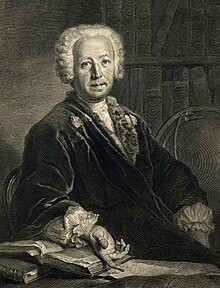Johann Theodor Eller
Johann Theodor Eller (born November 29, 1689 in Plötzkau ; † September 13, 1760 in Berlin ) was an important physician of the 18th century , chemist , Prussian military doctor and, from 1735, personal physician under Friedrich Wilhelm I and Friedrich II.
Life
Eller studied in Quedlinburg and Jena Law , later in Halle , Leiden , Amsterdam and Paris medicine and natural sciences . Louis Lemery and Wilhelm Homberg aroused his interest in chemistry. A stay in London brought him further good relationships.
After his return in 1721 he became the personal physician and physician of the Prince of Anhalt-Bernburg , where he was the first in Germany to vaccinate smallpox . Two years later he was called to Prussia and in 1724 became a field medic, doctor at the Friedrichs Hospital in Berlin and professor at the Collegium medico-chirurgicum , which was founded in the same year. In 1725, together with Georg Ernst Stahl, he was the author of a "medical edict" which laid the foundation for a more in-depth anatomical and surgical training, state examination and approval of doctors and other medical professions. Together with the surgeon and military doctor Gabriel Senff († 1738), he managed the Charité in Berlin , which opened in 1727, for eight years . In 1735 he became director of the physical class of the Society of Sciences and personal physician to the Prussian kings. In 1755 he became director of the Collegium medico-chirurgicum . In 1738 he was awarded the academic nickname I. Euphorbus a member ( Matriculation no. 484 ) of the Leopoldina selected.
Johann Theodor Eller died in Berlin in 1760 at the age of 70. He was buried in the churchyard at the Dorotheenstädtische Church . The tomb was lost when the church and churchyard were leveled in 1965 at the latest.
Fonts
- Catalogus rerum mineralium et metallicarum , Bernburg 1723
- Useful and exquisite medical and surgical remarks on both internal and external diseases, and some operations carried out during the same, which so far in the one of Sr. Königl. Great Lazareth of the Charité in Berlin donated by Majesty in Prussia, occurred; In addition to a brief description of the foundation, growth and current condition of this house , Berlin 1730
literature
- Jörg Heinrich: Johann Theodor Eller. An important doctor, scientist and medical officer in Brandenburg-Prussia in the first half of the 18th century. Matthiesen Verlag, Husum 2003 (Treatises on the History of Medicine and Natural Sciences 93), ISBN 978-3-7868-4093-0
- Hermann Frölich, Alphons Oppenheim: Eller, Johann Theodor . In: Allgemeine Deutsche Biographie (ADB). Volume 6, Duncker & Humblot, Leipzig 1877, p. 52 f.
- Johann Daniel Ferdinand Neigebaur : History of the imperial Leopoldino-Carolinische German academy of natural scientists during the second century of its existence. Friedrich Frommann, Jena 1860, p. 215 digitized
- Manfred Stürzbecher: Eller, Johann Theodor. In: New German Biography (NDB). Volume 4, Duncker & Humblot, Berlin 1959, ISBN 3-428-00185-0 , p. 456 ( digitized version ).
Web links
- Member entry of Johann Theodor Eller at the German Academy of Natural Scientists Leopoldina
- Biographical data and portrait of Johann Theodor Eller
- Digitized version of the "Medicinal Edict" of September 27, 1725
Individual evidence
- ^ Hans-Jürgen Mende: Lexicon of Berlin burial places . Pharus-Plan, Berlin 2018, ISBN 978-3-86514-206-1 , p. 40.
| personal data | |
|---|---|
| SURNAME | Eller, Johann Theodor |
| ALTERNATIVE NAMES | Euphorbus I. |
| BRIEF DESCRIPTION | Prussian physician and chemist |
| DATE OF BIRTH | November 29, 1689 |
| PLACE OF BIRTH | Plötzkau |
| DATE OF DEATH | September 13, 1760 |
| Place of death | Berlin |
